- Home
- Jared Diamond
The Third Chimpanzee: The Evolution and Future of the Human Animal Page 5
The Third Chimpanzee: The Evolution and Future of the Human Animal Read online
Page 5
Depending upon the species, females enter estrus at various time intervals, from every few weeks to a few times a year. Females of some species enter estrus just once a year. Then and only then are they willing to copulate with males, and they advertise this fact to males through behavior and, sometimes, changes in their appearance.
Human sexual cycles are quite different. Instead of being limited to a short estrus phase, a sexually mature woman, like a man, may choose to engage in sexual activity whenever she decides to do so. Women ovulate once a month, but unlike other primate females, they do not advertise this fertile phase to males with changes in their appearance or behavior. In fact, human ovulation is so well concealed, from women as well as men, that doctors only began to understand its timing in the 1930s.
Concealed ovulation, together with the fact that women have the ability to be sexually active when they want and not just during the time of the month when they are fertile, means that most sexual encounters by humans are at the wrong time for conceiving a child. Whatever the main biological function of human sex might be, it isn’t to produce children. In no species besides humans has sex become so unconnected to conception.
For animals, copulation is a dangerous luxury. Animals in the act of mating burn energy and neglect opportunities to obtain food. They are also vulnerable to predators who want to eat them or rivals who want to take over their territory. Copulation is something to be accomplished in the minimum time needed for fertilization.
If we regarded human sex as a means of achieving fertilization, it would be a colossal failure in evolutionary terms. It gets the job done, but it consumes a great deal of time and energy, because humans engage in much sexual activity at times when fertilization is impossible or unlikely. If we had kept an estrus cycle like other mammals, including our close primate relatives, our hunter-gatherer ancestors could have spent that wasted time butchering more mastodons and gathering more berries.
The most hotly debated question in the evolution of human sexuality is how we wound up with concealed ovulation, and what good all those mistimed copulations do us. Sex is pleasurable, but evolution made it that way. If our species weren’t getting some evolutionary benefit from our sexual activities, the world would have been taken over by mutant humans who evolved not to enjoy sex.
Closely related to the question of concealed ovulation is that of concealed copulation. All other animals that live in groups—whether individuals are monogamous or have multiple partners— copulate in full view of the other animals in their group. Why are humans unique in our strong preference for keeping our sexual activity private?
Biologists are currently arguing over theories to explain the origin of concealed ovulation and copulation in humans. From an evolutionary point of view, some factor or combination of factors caused us to evolve these traits in the distant past. The traits would not still be present today if some factors weren’t keeping them alive. The factors responsible for concealed ovulation and copulation today don’t necessarily have to be the same factors that caused those traits to appear in the first place. Three of the explanations biologists have suggested for the origin of our unusual sex lives, however, seem to me to be still in operation today.
Those explanations are:
* Concealed ovulation and copulation evolved to reduce aggression and increase cooperation among males;
* Concealed ovulation and copulation strengthen the bonds between particular couples, laying the foundations of the human family; and
* Women evolved concealed ovulation to encourage men to bond permanently with their partners, which in turn makes men more confident that they are the fathers of the children their partners bear.
All these explanations reflect a key feature of human social organization. A man and woman who want their child (and their genes) to survive must cooperate with each other for a long time to rear that child. At the same time, they must cooperate economically with other couples living close by. Regular sexual relations between the man and woman create a bond that is closer than the couple’s ties to their friends and neighbors. These close bonds between couples are a kind of social cement, not just a mechanism of fertilization. Our sex lives take place in private to emphasize the difference between sexual and nonsexual partners within the same close group.
The Science of Adultery
The human mating system is based on male and female pairs that rear children together and form a lasting bond. Another primate species also forms lasting pairs: the little apes called gibbons. Their mating system is different from that of humans, however. Gibbon couples live alone, apart from other gibbons, not in groups or communities. Gibbons who have formed a pair bond do not have sex outside the bond.
Humans live in social groups, not solitary pairs. They also, at times, engage in sexual activity with people other than their partners. Sexual activity by married people outside their marriage, called adultery or extramarital sex, is an exception to our “normal” pattern of married sex.
Adultery can be a heartbreaking, life- wrecking matter. Why, then, do humans do it? Like other behaviors, adultery can be examined from the point of view of evolution. Remember that when we use the framework of evolutionary biology, we look at patterns across whole species, and evolution is only one of the forces that drive human behavior.
If life is viewed as an evolutionary contest, the winners are those who leave the greatest number of offspring. Different species have different strategies for winning the contest. Some species are purely monogamous, others are highly promiscuous (meaning that individuals may mate with many partners), and some follow a mixed strategy: monogamous, with exceptions.
Within any species, the best strategy for males may not be the same as the best strategy for females. That is the case with humans. For men, the minimum effort needed to produce an offspring is copulation, which requires only a little time and energy. For women, the minimum effort is copulation plus nine months of pregnancy—and, throughout most of human history, several years of nursing as well. That’s a huge investment of time and energy. As a result, a man can potentially produce far more offspring in his lifetime than a woman can. The record lifetime number of offspring for a man is 888, sired by Emperor Ismail the Bloodthirsty of Morocco. The record for a woman is 69 children, born to a nineteenth-century Russian woman who had multiple sets of triplets. Few women have topped twenty children, while some men in polygynous societies easily do so.
This biological difference means that a man can potentially gain much more from extramarital sex than a woman can—if the only measure of success is the number of offspring. That could be one reason a man might seek sex outside marriage. Why would a woman? Research in many parts of the world suggests that women’s motives for sex outside marriage often include dissatisfaction with their marriages and a desire to find a new lasting relationship.
Does all this mean that extramarital sex is “only natural” and should be accepted? Not at all. Understanding and explaining a behavior is not the same thing as defending or accepting it. The goal of all human activity can’t be reduced to an evolutionary drive. We humans are able to choose other goals. Many people are simply not interested in relationships with people other than their partners. For others, goals such as honoring a promise to be faithful to one’s partner, staying true to religious and moral beliefs, or protecting the family are stronger than the urge to engage in extramarital sex. Among our species, success and happiness are not measured only by the number of offspring we leave. For evidence, consider the fact that many successful and happy women and men choose to limit their family size, or not to have children. Consider also that many humans form same-sex bonds, or have gender identities beyond traditional male and female roles.
MONOGAMOUS BIRDS—OR ARE THEY?
IN THE ANIMAL WORLD, THE CLOSEST MATCH to the human mating system is found in the nesting colonies of certain birds. Herons and gulls, for example, breed and rear their young in dense colonies of male-female pairs that appear m
onogamous. Successful chick rearing calls for two parents. One bird cannot raise a chick alone, because an unguarded nest will probably be destroyed while the parent is off gathering food, and a male cannot feed and guard two nests at the same time.
In a study of great blue herons and great egrets in Texas, observers watched males who were left guarding their nests while their mates went offto find food. For the first day or two after pairing with their mates, the males often courted other passing females, although they did not copulate with them. The courting seemed to be a kind of “insurance,” in which a male tried to line up a backup mate in case his female deserted him (which happens in 20 percent of cases). The passing “backup” female is a single bird seeking a mate. She does not know the male already has a mate until his spouse returns to chase her away. Eventually the male gains complete confidence that his spouse will not desert him, and he stops courting the passing females.
Ardea herodias or great blue herons, and their nests.
Herring gulls follow a different strategy. A study of these birds in Lake Michigan found that 35 percent of the mated males engaged in extramarital sex. All mated female gulls, however, rejected the advances of males other than their mates, and they never flirted with neighboring males when their mates were away. All the male gulls who committed “adultery” did so with single females. At the same time, these males were “good providers”—they brought their mates plenty of food.
Studies such as these have shown that so-called “monogamous” birds are not always monogamous. In some species, adulterous males try to have it both ways: keeping their spouses faithful while siring and their nests. offspring with other females.
A Choice among Goals
We are not mere slaves to the traits we have evolved, not even to those encoded in our genes. Modern civilization is fairly successful at ending ancient behaviors such as stealing brides from rival tribes or murdering children. While the evolutionary viewpoint is valuable for understanding how human social and sexual practices originated, it is not the only way to understand the way we behave today.
Once human culture was firmly in place, it acquired new goals. Questions of sexual faithfulness or promiscuity are not decided simply by our evolutionary heritage. They are also ethical questions, involving our ideas and beliefs about right and wrong behavior. Like other animals, we evolved to win at the contest of leaving as many descendants as possible, but we have also chosen to pursue ethical goals, which can direct our behavior in different ways. Having that choice among goals is one of the biggest differences between us and other animals.
How We Pick Our Mates
One final piece of the puzzle that is human sexuality concerns the mystery of attraction. What draws us to one possible partner instead of another? How do we choose our mates?
Psychologists have tackled this question by examining many married couples, measuring everything conceivable about them and then trying to make sense out of who married whom. Not surprisingly, most husbands and wives turn out to share the same ethnic background (although racially and ethnically mixed marriages are on the rise), religious beliefs, and political views. Spouses also tend to match each other reasonably well in intelligence and in personality qualities such as neatness.
What about physical appearance? It turns out that if you measure enough couples, you make an unexpected discovery. There are many exceptions, but on average, spouses resemble each other slightly—but enough to be statistically significant—in almost every physical feature. This is true for the obvious physical features we think of first when describing people: height, weight, and color of eyes, hair, and skin. But it is also true for dozens of less obvious traits, such as breadth of nose, length of earlobe or middle finger, distance between eyes or around the wrist, and lung volume! Experimenters have made this finding for people as far apart as Poles in Poland, Americans in Michigan, and Africans in Chad. In each case, spouses were not identical, but they were more alike than they would have been if they had been randomly paired.
In spite of the old saying “opposites attract,” people on average tend to marry people who are more like them than they are different. One reason for this is that we tend to spend a lot of time around people who are similar to us. Many people live in neighborhoods defined by ethnic background, or religion, or social and economic status. We meet people of the same religion in church. Family friends often share our own family’s interests, political views, and social and economic status.
Those contacts give us many opportunities to meet and fall in love with someone similar to ourselves. But we don’t live in neighborhoods grouped by length of earlobe, so there must be some other reason spouses tend to be matched that way, too. The answer lies in physical attraction based on appearance. All kinds of traits—the obvious ones such as height and hair color, and the less obvious ones such as earlobe length and eye spacing—come together to form a search image, a mental picture of our ideal mate. We may not be consciously aware that we have such an image, but it is what makes us feel that “He’s my type” or “She’s not my type” when we meet someone new.
We are attracted to people who look somewhat like us because our search images are based on people who share half our genes: our parents and siblings. We begin to develop our search image of a future partner when we are very young, between birth and age six. The image is heavily influenced by the people of the opposite sex whom we see most often. For most of us, that’s our mother or father, sister or brother, and close childhood friends.
We may have evolved to form an early search image of the ideal mate, but researchers have found time and time again that factors such as personality, intelligence, and religion have more influence than physical appearance on our choice of spouses. Like other aspects of our social and sexual lives, our feeling of attraction to possible romantic partners, and our eventual choice of partners, whether of the opposite sex or our own, is driven only partly by our evolutionary heritage. It is also determined by our life experiences, values, and goals.
Whatever their style, people more often than not choose mates who resemble them. Any new style can catch on—if enough potential dating and mating partners find it attractive.
CHAPTER 4
THE ORIGIN OF HUMAN RACES
IMAGINE YOU WERE INTRODUCED TO THREE people: one each from Nigeria, Japan, and Sweden. You would probably have no trouble deciding at a glance which person came from which country. You’d see differences in skin color, the color and shape of eyes, the color and texture of hair, and general body size and shape. These differences would point to different continents of origin: Africa for the Nigerian, Asia for the Japanese, and Europe for the Swede. A trained anthropologist might be able to do better, placing each person in the right part of his or her country.
Human features vary with geography, creating racial variations. Since scientists have answered so many highly technical questions about obscure species of plants and animals, you might expect them to have answered one of the most obvious questions about us: Why do people from different areas look different? Our understanding of how humans came to differ from other animals would be incomplete if we did not consider how, in the process, human populations became visibly different.
The subject of human races, however, is an explosive one. British scientist Charles Darwin shied away from it in his 1859 book On the Origin of Species, which introduced the world to the ideas that form the foundation of modern biology. Even today, few scientists dare to study racial origins, for fear they will be called racists just for being interested in the subject.
Another reason we don’t understand the meaning of racial variations is that it’s an unexpectedly difficult problem. Darwin’s own theory was that human races originated because of sexual selection—in other words, the mating choices people make. To this day, that theory is controversial. Modern biologists usually argue that racial origins came about through a different process, called natural selection. Yet they can’t even agree how natural selection m
ight have led to features such as dark skin in the tropics, to take just one example of racial variation.
In this chapter we’ll look at the two forces that have been suggested as the source of racial variations: natural selection and sexual selection. You’ll see that I think natural selection played only a secondary role, and that sexual selection has been the primary shaper of human racial variation.
Visible Variations
Racial variation is not confined to humans. Most animal and plant species that are distributed over wide areas, including gorillas and common chimpanzees, also vary geographically. This means that populations of the same species living in different parts of the species’ range have recognizable, visible differences.
How can we decide whether two recognizably different populations, from different places, belong to the same species? If no interbreeding occurs naturally when they come into contact, they are separate species. If interbreeding does occur, they belong to the same species, but because of their differences, they can be considered separate races (also known as subspecies) within that species. All gorillas, for example, belong to a single species. Within that species are three races, or subspecies, of gorillas: mountain, eastern lowland, and western lowland. They are set apart by visible differences in body size, hair length, and hair color.
Closely related species that occasionally interbreed in captivity, such as tigers and lions, remain separate species because they do not interbreed in the wild. All humans, in contrast, belong to the same species, because some interbreeding has taken place whenever any two human populations have come into contact.

 Why Is Sex Fun?: The Evolution of Human Sexuality
Why Is Sex Fun?: The Evolution of Human Sexuality Guns, Germs, and Steel: The Fates of Human Societies
Guns, Germs, and Steel: The Fates of Human Societies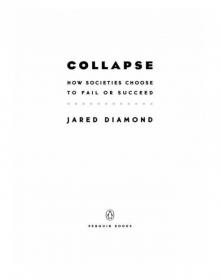 Collapse: How Societies Choose to Fail or Succeed
Collapse: How Societies Choose to Fail or Succeed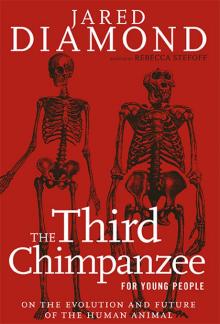 The Third Chimpanzee: The Evolution and Future of the Human Animal
The Third Chimpanzee: The Evolution and Future of the Human Animal The World Until Yesterday: What Can We Learn From Traditional Societies?
The World Until Yesterday: What Can We Learn From Traditional Societies?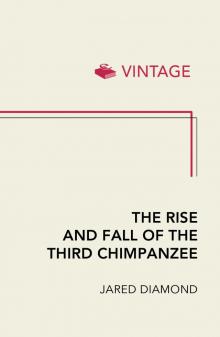 The Rise and Fall of the Third Chimpanzee
The Rise and Fall of the Third Chimpanzee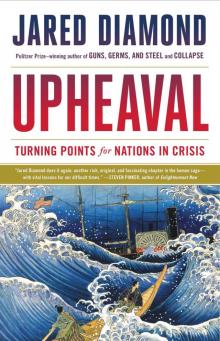 Upheaval: Turning Points for Nations in Crisis
Upheaval: Turning Points for Nations in Crisis Guns, Germs, and Steel
Guns, Germs, and Steel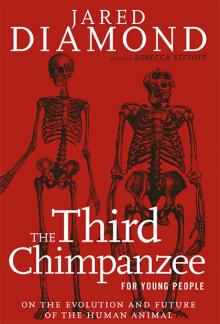 The Third Chimpanzee for Young People
The Third Chimpanzee for Young People Why Is Sex Fun?
Why Is Sex Fun?